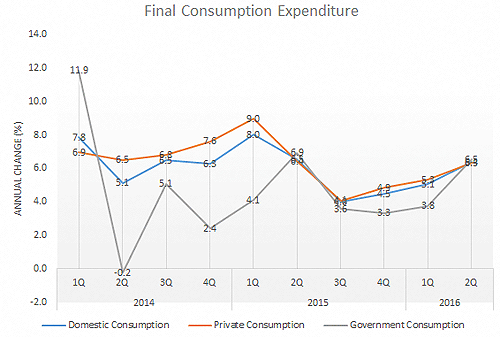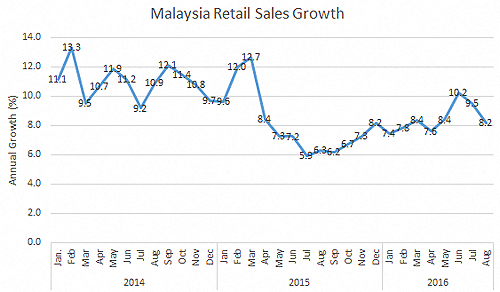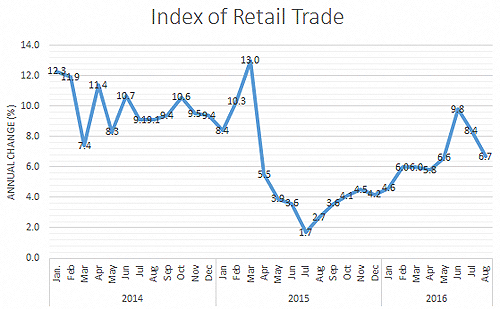The news of the day is the Goods and Services Tax or GST (again!) and Malaysia’s economy.
The prime minister was answering the question of Liew Chin Tong, the MP from DAP, who suggested to government to reduce the GST rate to 3 percent from the current rate of 6 percent.
This suggestion made by Liew on his claim that GST is dragging down the domestic consumption.
Let’s fact-check Liew on whether or not GST has dragged and is dragging down the domestic consumption as he claimed in the Parliament.
First of all, the measure of metric for domestic consumption is the final consumption expenditure which consists of private final consumption expenditure and government final consumption expenditure that is recorded and published every quarter in the national accounts (GDP).
The chart below shows the annual changes of domestic consumption (final consumption expenditure) for every quarter since the first quarter of 2014:

From the chart above we can see that overall (private + government) domestic consumption grew every quarter.
Despite some slowdown post-GST implementation, domestic consumption has bottomed up in the third quarter of 2015 and rebounded since then.
Both private and government consumption saw a slowdown in annual growth in the second and third quarter of 2015.
Domestic consumption showed a slower growth rate but not contraction in consumption.
The claim by Liew that GST has dragged down the domestic consumption is not accurate because the data showed otherwise.
For a better metric of private consumption, let’s see whether GST has dragged down the retail sales and retail index.
The difference between retail sales and retail index is, the former measures the sales value (in ringgit) and the latter measures the sales volume/quantity (in unit/index):

Though there was a slowdown in retail sales growth right after GST was implemented, there was no contraction (negative growth) in retail sales and growth has rebounded since July last year four months after the implementation of GST.

Similar to retail sales, index of retail trade which measures the change in volume slowed down after April 2015 and rebounded about four months after and there was no contraction in volume of retail trade either.
Data of consumption, retail sales and retail volume show that there was a slowdown in domestic consumption after the implementation of GST.
As consumers adjusted to GST, consumption rebounded and grew steadily since then.
The claim that GST dragged down the consumption was only half-truth and Liew doesn’t acknowledge that domestic consumption had already rebounded.
The opposition, especially DAP, need to stop blabbering about GST and start acknowledging that GST hasn’t dragged the economy down.
The slowing economic growth should be attributed to the fall of commodities prices, slowing international trade activities, and uncertainties in the global markets.
GST is necessary and relevant to expand the tax base and reducing the volatility of the government’s revenue due to volatility in oil prices.
The suggestion to reduce the GST rate is not just irresponsible but also shows the lack of understanding in public finance among the oppositions.
References:
1. Final Consumption Expenditure: BNM Monthly Statistical Bulletin
2. Malaysia’s Retail Sales: Department of Statistics Malaysia
3. Index of Retail Trade: Department of Statistics Malaysia

